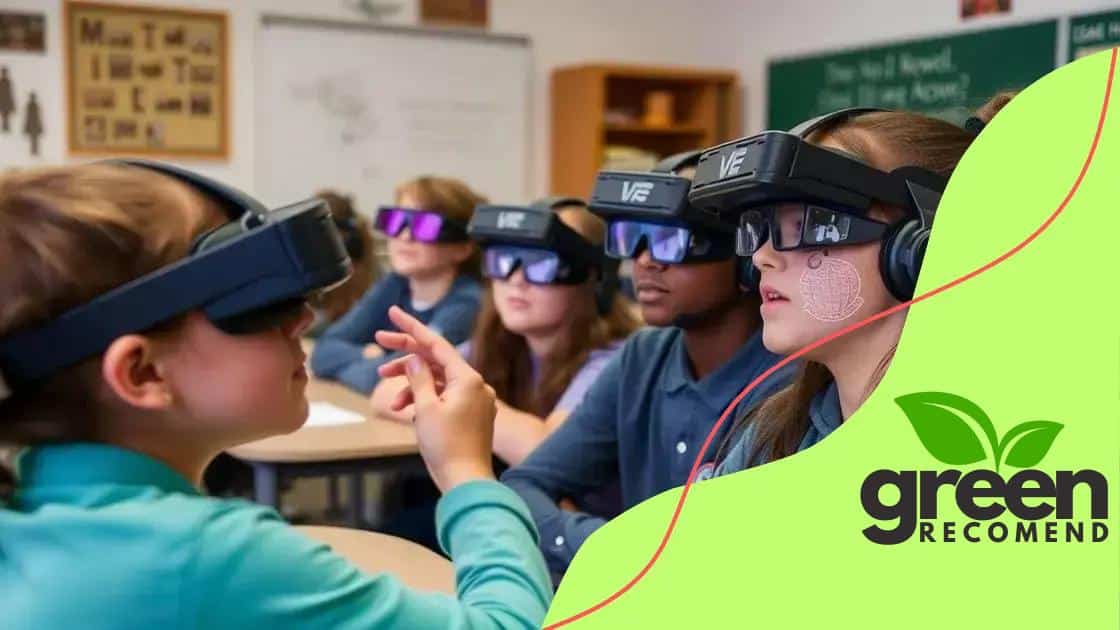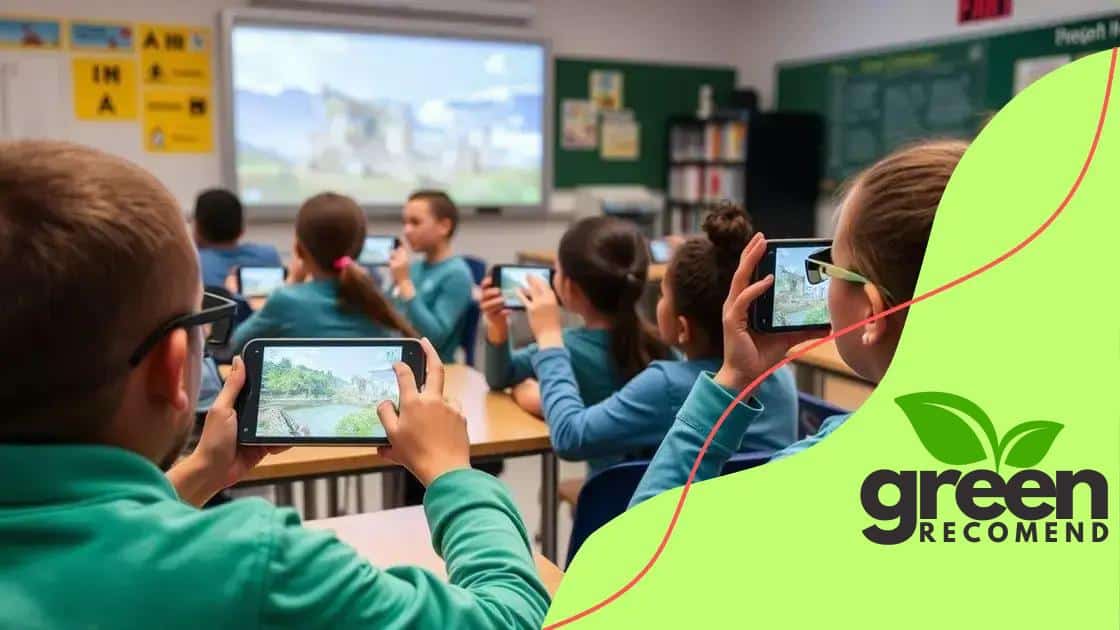How AR is being used for hands-on learning experiences

AR is revolutionizing hands-on learning by enhancing student engagement through interactive experiences, improving accessibility to complex concepts, and preparing learners for the future of education.
How AR is being used for hands-on learning experiences is not just a buzzword; it’s reshaping classrooms across the globe. Imagine students exploring ancient ruins or the human body right from their desks. Sounds intriguing, right?
The role of AR in modern education
The role of AR in modern education is expanding rapidly, bringing interactive and engaging experiences to students. By incorporating augmented reality, teachers can create a dynamic learning environment that captivates students’ attention.
Enhancing Classroom Engagement
With AR technology, students can visualize complex subjects in a way that traditional methods can’t. For example, science lessons transformed by AR can allow students to explore the human body or investigate molecular structures.
- Visualize anatomy through 3D models.
- Explore scientific concepts in real-time.
- Interact with historical events and figures.
This technology provides a hands-on approach to learning, which is crucial for retaining information. Students enjoy learning when they can see and manipulate objects directly, making AR a powerful tool in education.
Support for Diverse Learning Styles
One of the significant advantages of AR in education is its ability to cater to various learning styles. Visual learners benefit from seeing information in a 3D context, while kinesthetic learners thrive when they can interact with the material.
Teachers can leverage AR applications to supplement their lessons, allowing students to engage with educational content that resonates with their preferred learning methods. This personalized learning approach can improve overall educational outcomes.
Moreover, students with disabilities can access materials that are more suited to their needs, ensuring that everyone has the opportunity to learn effectively. As classrooms embrace AR technology, we may see substantial progress in how educational content is delivered and received.
In conclusion, the role of AR in modern education is transformational. By enhancing engagement and supporting diverse learning styles, AR creates a richer learning experience for students of all backgrounds.
Engaging students with interactive AR experiences
Engaging students with interactive AR experiences is revolutionizing the way we approach education. With augmented reality, learning becomes more immersive, allowing students to step into worlds they can only read about in textbooks.
Creating Real-Life Scenarios
Through AR applications, educators can create real-life scenarios that make lessons relatable and exciting. For instance, science classes can transform into interactive laboratories where students conduct virtual experiments.
- Explore the life cycle of plants in a virtual garden.
- Visit ancient civilizations through immersive historical simulations.
- Understand complex math problems by visualizing geometric shapes.
Such experiences not only enhance understanding but also foster a deeper interest in subjects. When students interact with the material, they’re more likely to remember what they learn.
Collaboration and Teamwork
Another exciting aspect of interactive AR is the ability to encourage collaboration among students. Group projects can be enhanced with AR tools that allow students to work together in a virtual space, fostering teamwork and communication skills.
This collaboration can lead to improved social interaction, as students must share ideas and solve problems together. In essence, AR not only makes learning fun but also teaches essential life skills.
As we incorporate more interactive AR experiences in education, we see increased student motivation and engagement. This shift paves the way for innovative methods of teaching that cater to the needs of today’s learners.
Real-world applications of AR for hands-on learning

Real-world applications of AR for hands-on learning are transforming the education landscape. Augmented reality provides tools and experiences that encourage students to engage actively with learning materials, making education more relevant and exciting.
Field Trips Without Leaving the Classroom
With AR technology, students can experience field trips from the comfort of their classrooms. For example, they can explore the Great Wall of China or dive into the depths of the ocean, all through interactive simulations.
- Visit historical sites via immersive AR experiences.
- Explore diverse habitats and ecosystems interactively.
- Engage in virtual tours of museums and galleries.
Using AR not only brings lessons to life but also allows students to connect with real-world contexts. This method can spark curiosity and inspire students to learn more about different cultures and environments.
Skill Development in Various Disciplines
Another significant application of AR for hands-on learning is in vocational training and professional skills development. Industries are increasingly using AR to train employees, providing realistic simulations that mimic real-life scenarios.
This training method allows learners to practice skills safely and effectively. For instance, medical students can perform virtual surgeries, while mechanics can work on 3D car models. This exposure ensures that students feel more prepared for the workforce.
As AR continues to evolve, we will likely see even more innovative applications that enhance hands-on learning experiences, making education not only informative but also engaging and fun. By bridging the gap between theory and practice, AR is paving the way for a more interactive future in learning.
Challenges and limitations of AR in education
Challenges and limitations of AR in education are critical to understand as this technology continues to evolve. While augmented reality offers exciting opportunities for interactive learning, there are some obstacles that educators and institutions must overcome.
Cost of Implementation
One of the main challenges is the cost of implementing AR technology in classrooms. Schools need to invest in hardware, software, and training for teachers to effectively integrate AR into lessons.
- Devices such as tablets and AR headsets are expensive.
- Licensing fees for educational software can add up.
- Ongoing maintenance and updates can strain school budgets.
This financial burden may prevent some schools from adopting AR, leaving students without access to this innovative learning tool.
Technical Challenges
Another limitation is the technical issues that can arise with AR applications. Poor connectivity or outdated devices can lead to a frustrating user experience. Inconsistent performance can hinder student engagement and diminish the benefits of AR.
Teachers must also be prepared to troubleshoot technical issues quickly. This can take valuable time away from teaching, disrupting the learning process. Effective training and support systems are crucial to mitigate these challenges.
Additionally, not all subjects or topics lend themselves well to AR solutions. Some concepts may be too abstract or complex for augmented reality to effectively convey. This limitation means that AR cannot replace traditional teaching methods but should complement them.<\/p>
Future trends in AR technology for learning
Future trends in AR technology for learning hold great promise for transforming education. As this technology advances, we can expect to see even more innovative applications that enhance student engagement and understanding.
Integration with Artificial Intelligence
One exciting trend is the integration of AR with artificial intelligence (AI). This combination can lead to more personalized learning experiences. Students will receive tailored content that adapts to their individual learning styles and pace.
- AI can analyze a student’s progress and suggest AR activities.
- Personalized feedback can foster deeper understanding.
- Engagement levels may rise as lessons become more relevant.
This integration can make learning not only more accessible but also more enjoyable for students.
Advancements in Hardware
Advancements in hardware will also play a crucial role in the future of AR in education. Devices are becoming lighter, more affordable, and more powerful, making AR experiences more accessible to schools. As technology improves, immersive AR will become a regular part of the classroom.
New developments could lead to:
- More user-friendly AR devices that require less training.
- Enhanced graphics and smoother functionality for richer experiences.
- Greater affordability, allowing wider adoption in schools.
With these advancements, the potential for engaging learning opportunities expands significantly.
Collaboration tools within AR environments are also on the rise. Students will be able to interact with their peers in shared AR spaces, promoting teamwork and communication skills. This collaborative approach can enhance problem-solving abilities and foster a sense of community among learners.
As AR technology continues to evolve, the possibilities for enriching education are virtually limitless, paving the way for a more interactive and personalized learning experience.
In conclusion, augmented reality (AR) is changing the way we learn. By making education more interactive and engaging, AR helps students connect with the material in exciting ways. Despite some challenges, such as costs and technical issues, the future of AR in education looks promising. As technology continues to advance, we can expect even more innovative applications that enhance learning experiences. With greater accessibility and collaboration, AR will play a vital role in shaping the classrooms of tomorrow.
FAQ – Frequently Asked Questions about AR in Education
What is augmented reality (AR)?
AR is a technology that overlays digital information, such as images and animations, onto the real world, enhancing the way we experience and learn.
How can AR improve student engagement?
AR makes learning interactive and fun, helping students connect with the material more deeply and increasing their interest in subjects.
What are some challenges of using AR in classrooms?
Challenges include high costs of implementation, technical difficulties, and ensuring that all students have access to the necessary devices.
What are the future trends for AR in education?
Future trends include the integration of AI for personalized learning, advancements in hardware, and increased collaboration opportunities among students.





